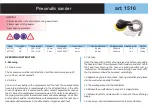
1200W 4" BELT SANDER
Following this rule will reduce the risk of serious personal injury.
5. Remove the plug from the socket before carrying out any adjustment, servicing or
maintenance.
6. Fully unwind cable drum extensions to avoid potential overheating.
7. When an extension cable is required you must ensure it has the correct ampere rating for
your power tool and is in a safe electrical condition.
8. Ensure your mains supply voltage is same as indicated on the rating plate.
9. Your tool is double insulated for additional protection against a possible electrical insulation
failure within the tool.
10. Always check walls, floors and ceilings to avoid hidden power cables and pipes.
11. After long working periods external metal parts and accessories could be hot.
12. If possible, ensure the work-piece is firmly clamped to prevent movement.
13. Your sander is a hand held tool, do not clamp your sander.
14. Before sanding, check the area is free of nails, screws, etc.
15. Never stop the sander by applying a force to the base plate.
16. Only use paper in good condition. Do not use torn or worn paper.
17. Do not sand material containing asbestos due to a health risk.
18. Do not sand lead based paint due to the risk of lead poisoning.
19. Do not eat or drink in the working area of the sander.
20. Do not allow people to enter the working area without wearing a dust mask.
21. Where possible, seal off the working area to contain the dust for later removal.
22. Your tool is designed for dry sanding only, not wet sanding.
23. Your tool is designed for general purpose light polishing of wood and metals.
24. Do not sand magnesium material due to the risk of fire.
Warning: Some dust particles created by power sanding, sawing, grinding, drill
and other construction jobs contain chemicals known to cause cancer, birth
defects or other reproductive harm.
Some examples of these chemicals are:
• Lead from lead-based paints.
• Crystalline silica from bricks and cement and other masonry products.
• Arsenic and chromium from chemically treated timber.
Your risk from these exposures varies, depending upon how often you do this type of work. To
reduce your exposure to these chemicals:
• Work in a well-ventilated area.
• Work with approved safety equipment, such as those dust masks that are specially designed
to filter microscopic particles.
Содержание ERB378SDR
Страница 1: ...1200W 4 BELT SANDER ERB378SDR...
Страница 2: ...Original Instructions Version 2 0...
Страница 10: ...1 3 5 8 4 2 1 7 6...
Страница 19: ...1200W 4 BELT SANDER...
Страница 20: ......






































